What kind of whiteboards should I use?

Whiteboards are a great tool for students to work out ideas individually and collaboratively, and to present those ideas, both for public discussion and critique of tentative ideas and for communication of more fully formed ideas. There are many different kinds of whiteboards, each with their own advantages and disadvantages. While there is little research that systematically compares different kinds of whiteboards, expert educators who have used different types of whiteboards often report similar experiences regarding the kind of pedagogy that each one is best at supporting. Based on reports from expert educators, this recommendation discusses the questions you should ask when choosing whiteboards, the advantages and disadvantages of each type of whiteboard, product suggestions for markers and whiteboards, and the advantages of whiteboards over other collaboration tools. For suggestions about how to use whiteboards in your classroom, see our recommendation on Best practices for whiteboarding in the physics classroom.
Questions to ask when choosing whiteboards
- Do you want students to use the whiteboards in small groups or individually? Small whiteboards (~ 9" x 12" or 12" x 16") are best for students to use individually, and medium whiteboards (~ 18" x 24" or 24" x 32") are best for creating a shared collaborative space for a small group. If the space is very large, such as a whole wall or whole table, more students are likely to write on the board, but they are likely to do so individually in their own corners rather than collaboratively in a single shared space.
- Do you want to optimize for working out ideas, presenting ideas, or both? Whiteboarding is a great tool both for working out ideas and for presenting ideas, but different whiteboard configurations support these two practices in different ways. Placing a whiteboard horizontally on the table is better for collaboration because all students can reach and write on the whiteboard. With a vertical whiteboard, it is logistically difficult for more than one student to write at a time, so you are more likely to have one student standing and writing while the other students watch. Vertical whiteboards are better for presenting ideas because other students and the instructor can see them. Portable whiteboards are ideal for both because they can be placed on the table for collaboration, and then held up or placed against the board for presentation.
- Do you want to create a permanent classroom fixture or a portable classroom tool? Permanent fixtures, such as whiteboards attached to the walls or whiteboard tabletops, create an immediate visual cue that this is a classroom where students work out ideas publically, which helps set the culture and influence how both students and instructors use the space. If your goal is to push the culture of your department or institution towards more interactive learning, this is a great way to do it [Foote et al. 2016, Knaub et al. 2016]. Permanent fixtures also avoid the hassle of storing, transporting, and distributing portable whiteboards. However, if you don’t have control over the physical layout of your classroom, portable whiteboards are the way to go. Portable whiteboards also offer more functionality and flexibility in terms of being good for both collaboration and presentation, so if you aren’t worried about your ability to create a classroom culture through visual cues, they will probably work better.
- How much can you afford to spend? Portable whiteboards are a lot cheaper than whiteboard tables or whiteboard walls. You can make portable whiteboards for a few dollars each by purchasing a large sheet of "hardboard wall panel" at a hardware store and asking them to cut it for you (see details below under Product suggestions). You can also make whiteboard walls fairly cheaply by just painting the walls with whiteboard paint.
- How much space do you have at your table? Tabletop whiteboards are better for creating a shared collaborative space that all students can access equally, but can be easily blocked by computers, equipment, or backpacks. If you need to have a lot of other things on the table for students to use, a rolling or wall whiteboard may be a better option. If you have a large table for each group, a 24" x 32" portable whiteboard for each group (recommended by the developers of Modeling Instruction) gives more space to write big enough to present and makes it easier for all students to reach the whiteboard. If you are using round SCALE-UP tables with three groups at each table, a 18" x 24" portable whiteboard (recommended by the developer of SCALE-UP) may fit better around the table.
Different types of whiteboards:
Medium portable whiteboards (~ 18" x 24" or 24" x 32")
Best for small groups of students to collaboratively work out ideas and share their work
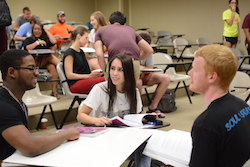 Advantages:
Advantages:
- Large enough for multiple students to easily write on them at the same time, creating a sense that there is a shared collaborative work space
- Can be easily picked up and moved to present work to others
- Can be made very cheaply by buying a large sheet of wall panel at a hardware store and asking them cut it
Disadvantages:
- May be hard to fit around students’ backpacks, computers, equipment on tables
- May have to be stored between classes and transported to and from class
Small portable whiteboards (~ 9" x 12" or 12" x 16")
Best for individual students to work out ideas and share their work
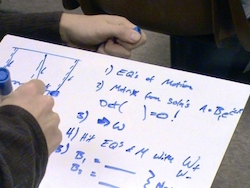 Advantages:
Advantages:
- Large enough for each student to work out a problem and show their work to others
- Can be easily picked up and moved to present work to others
- Can be made very cheaply by buying a large sheet of wall panel at a hardware store and asking them cut it
Disadvantages:
- May be hard to fit around students’ backpacks, computers, equipment on tables
- May have to be stored between classes and transported to and from class
Whiteboard tabletops
Best for making whiteboards accessible to all students
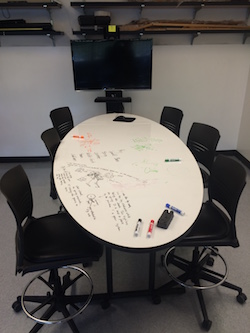 Advantages:
Advantages:
- Create an immediate visual cue that this is a classroom where students work out ideas publically, which will impact how both students and instructors use the space
- Easily accessible to all students at the table, so more students are likely to write and contribute ideas
- Always available without any special effort to transport or store
Disadvantages:
- Because the space is larger and less well-defined than a portable whiteboard, students are more likely to write privately in their own corner rather than working collaboratively
- Easily blocked by students’ backpacks, computers, equipment on tables
- Can’t be picked up and moved to present work to others
- More expensive than portable whiteboards
Large wall whiteboards
Best for creating a culture of whole classroom collaboration and presentation
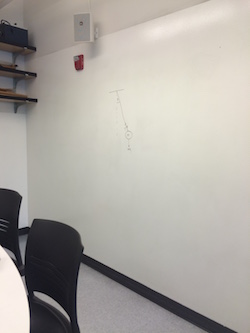 Advantages:
Advantages:
- Create an immediate visual cue that this is a classroom where students work out ideas publically, which will impact how both students and instructors use the space
- Not blocked by students’ backpacks, computers, equipment on tables
- Easy for instructors to see from across the room and get a sense of each group’s progress
- Easy for groups to present their work to other groups
- Always available without any special effort to transport or store
Disadvantages:
- Because they are typically larger, or span the whole wall, it may be more difficult for a group of students to feel like their have a defined space for their group
- Because the whole class can see them, students may be less inclined to use them for working out ideas that might be wrong (this problem should go away quickly if you set up a classroom culture where making mistakes is OK)
Rolling whiteboards
Best for creating the feel of a “poster session” for students to share results with the whole class
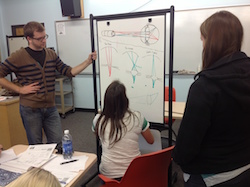 Advantages:
Advantages:
- Well-defined space for each group, creating a sense of group ownership of the whiteboard
- Not blocked by students’ backpacks, computers, equipment on tables
- Easy for instructors to see from across the room and get a sense of each group’s progress
- Easy for groups to present their work to other groups
Disadvantages:
- Logistically difficult for more than one student to write on them at a time, so there is more likely to be one student in control of the writing and less collaboration
- May have to be stored between classes and transported to and from class
- Because the whole class can see them, students may be less inclined to use them for working out ideas that might be wrong (this problem should go away quickly if you set up a classroom culture where making mistakes is OK)
Product suggestions
(Note: PhysPort is not being paid by any of the companies listed below, but if you work for one of them and want to pay us, please contact us.)
- Refillable non-toxic whiteboard markers: AusPen makes refillable markers that are easy to erase, don't smell, don't leave dust, and don't stain clothes. These were highly recommended by Zeke Kossover on the physlrnr listserv.
- Making portable whiteboards from hardboard wall panel: The cheapest way to make portable whiteboards is to buy a large sheet of "hardboard wall panel" at a hardware store and asking them to cut it for you. Hardboard wall panel usually comes in 4' x 8' sheets, which can be cut to make 6 24" x 32" group whiteboards, 10 18" x 24" group whiteboards, or 24 12" x 16" whiteboards. As of 2016, you can purchase a sheet at Lowe's or Home Depot for less than $15. According to the Paradigms in Physics team, "You should be able to purchase the whiteboard material at any home improvement store. It is technically melamine, but that word just confuses many employees; instead ask for 'that shiny white shower board stuff'... Make sure that it is smooth and shiny and on a thin backing. Backing should NOT be plywood (it comes this way, but is too heavy). Thickness maybe 1/4 inch." One disadvantage of wall panel is that it can get stained and scratched easily, so it may not last as long as higher quality whiteboards.
- Making rolling whiteboards: The Institute of Design at Stanford has plans for making rolling whiteboards out of garment racks.
- Pre-made portable whiteboards: If you don't want to cut your own, you can buy pre-cut whiteboards from Whiteboards USA, a company started by physics educator Carl Wenning, who provides many pedagogical suggestions for how to use them, or from The Markerboard People, recommended by Kossover. These whiteboards are a lot more expensive than wall panel, but they are also higher quality and will last longer.
- Whiteboard paint: One cheap and easy way to create whiteboard walls is to cover regular walls with whiteboard paint. If the walls are textured they won't be quite as nice to write on as smooth walls, and will need to be erased daily to prevent staining.
Advantages of whiteboards over other collaboration tools
- Whiteboards vs. large sheets of paper: Before whiteboards became widely and cheaply available, many research-based teaching methods in physics (e.g. Tutorials in Introductory Physics, Modeling Instruction), used a large sheet of paper in the middle of the table that students could write on. However, according to Megowan-Romanowicz and others who have observed students using both whiteboards and paper, whiteboards are better at encouraging students to collaboratively work out and share ideas. Megowan-Romanowicz observed students using both whiteboards and chart paper. She found that with whiteboards, because of the ease of writing and erasing, "students began writing right away. They started and stopped and erased all the time, and the representations that ultimately appeared evolved as the conversation unfolded. Although there were still some group members that did not write, there were many more instances of multiple students writing/drawing on the whiteboard in each episode. In addition, students who never wrote did occasionally erase what others wrote, or suggested that what others wrote should be erased and re-represented." With paper, because it is difficult to erase, she found that students were less likely to write down ideas until they had already worked them out verbally, "so a great deal of the reasoning process surrounding what was ultimately was shown was completed before much was written on the chart paper." Further, she "observed that the 'chart paper writer' was almost always the same person each time–sometimes it was the person who drew the best, or the one with the clearest writing, often it was the one who was most assertive in seizing the marker. This influenced what appeared on these chart paper representations. It was that writer's 'version' of the group's thoughts."
- Whiteboards vs. chalkboards: In theory you could use a chalkboard for any pedagogy that uses a whiteboard. But they are dusty, hard to erase, and hard to see, so unless you happen to have a lot of chalkboards that you can't get rid of or you have a severe reaction to the smell of whiteboard pens, we don't recommend them. And if you do have a severe reaction to the smell of whiteboard pens, see our suggestion above for non-toxic pens.
- Whiteboards vs. tablets or smart boards: Electronic solutions, ranging from tablets that students can use at their tables to large presentation screens that students and instructors can interact with. If you google whiteboard apps, you can find many programs that allow students to write collaboratively on tablets in the same way they write on whiteboards. These are not yet commonly used enough that we know whether they work as well as whiteboards, but might be worth trying if you already have tablets for your students. However, as Frank Noschese discusses in his blog post on The $2 Interactive Whiteboard, it can be too easy for students to get distracted by all the bells and whistles of these technologies and interact with the technology rather than each other. Simple cheap whiteboards allow students to focus on working out their own ideas.
Cover image ©Stephanie Schulz/ or Chandler Prude – Texas State University CCBY
 Add a Comment
Add a Comment


